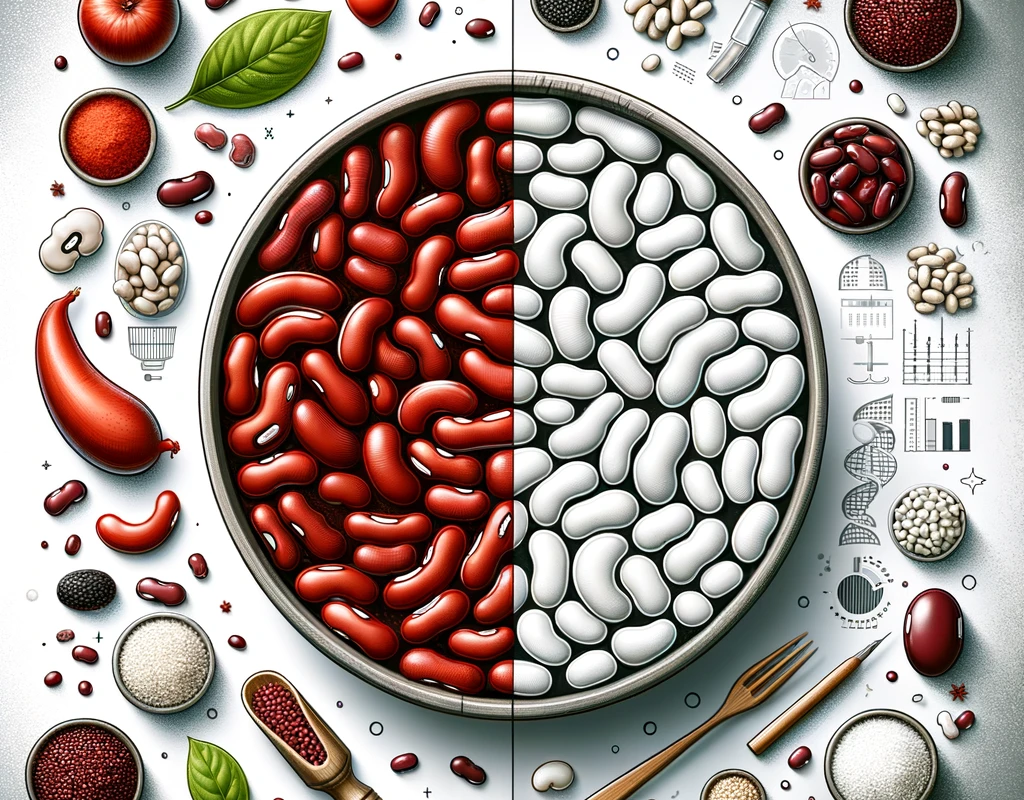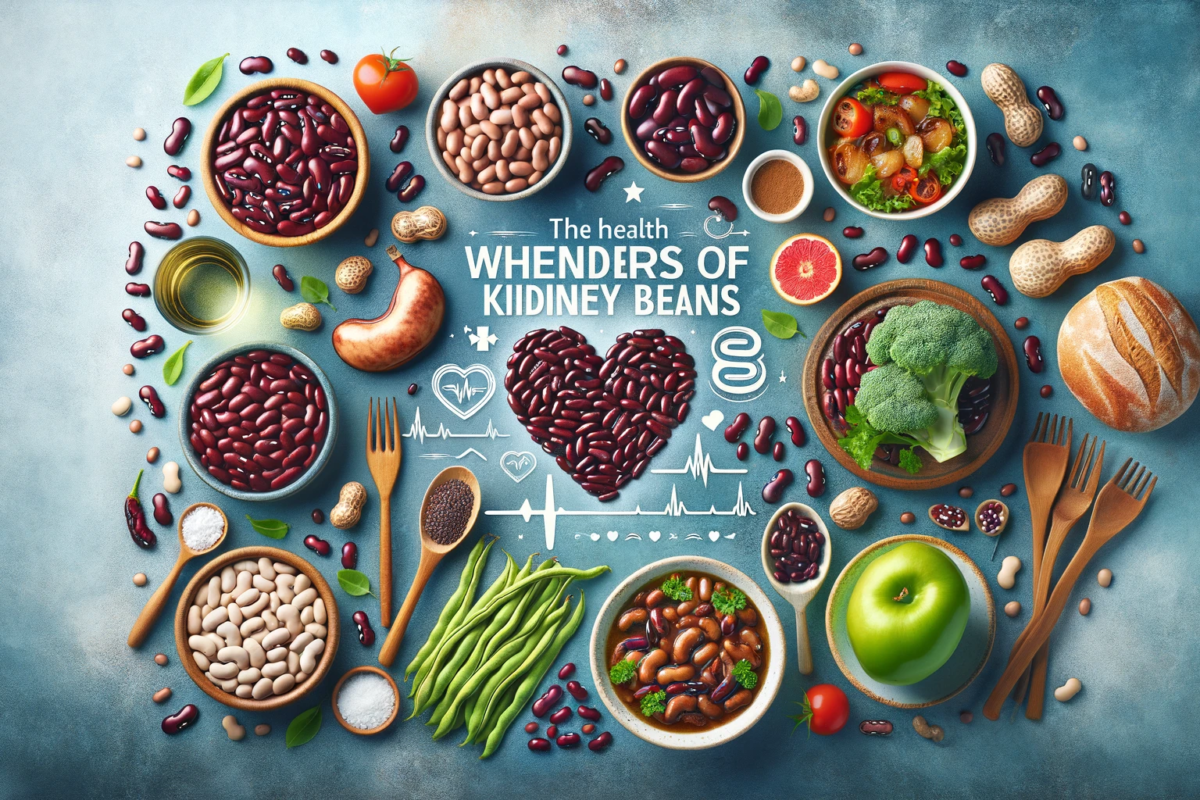Kidney beans, named for their kidney-like shape, are a staple in various cuisines around the globe. These legumes are not only celebrated for their rich, hearty flavors but also for their significant nutritional benefits. In this introductory section, we embark on a journey to explore the fascinating world of kidney beans, focusing on two popular varieties: red kidney beans and white kidney beans.
While both red and white kidney beans are integral to many traditional dishes, they possess distinct characteristics that set them apart. This article aims to shed light on these differences, providing a detailed comparison. From their nutritional values to their culinary applications and health benefits, we will delve into every aspect of these beans, offering a comprehensive guide for both cooking enthusiasts and health-conscious individuals.
Understanding these differences is not just about making an informed choice for your next meal. It’s about appreciating the diversity of nature’s offerings and how even seemingly similar ingredients can have unique stories, flavors, and benefits. Let’s begin this flavorful journey by comparing the nutritional aspects of these two bean varieties.
Nutritional Comparison
Nutritional Value Overview
Red and white kidney beans, while similar in shape, offer varied nutritional profiles. Both are excellent sources of plant-based protein, making them a staple in vegetarian and vegan diets. They are also rich in essential nutrients like iron, potassium, and B vitamins, which play vital roles in maintaining good health.
Despite these similarities, there are nuances in their nutritional makeup. Red kidney beans are slightly higher in antioxidants, thanks to their vibrant color, which comes from natural compounds like anthocyanins. White kidney beans, on the other hand, often have a marginally higher calcium content. These differences, though small, can influence dietary choices for those with specific nutritional needs.
Understanding the nutritional content of these beans is crucial for anyone looking to incorporate them into a balanced diet. Whether you are an athlete looking for protein-rich foods, or someone managing a health condition that requires careful nutrient monitoring, knowing these details can help make more informed dietary decisions.
Dietary Fiber and Protein
Dietary fiber is a crucial component of a healthy diet, and both red and white kidney beans are excellent sources. Fiber aids in digestion, helps maintain stable blood sugar levels, and contributes to a feeling of fullness, which can be beneficial for weight management. The fiber content in these beans also plays a vital role in promoting gut health.
In terms of protein, kidney beans are a powerhouse. They are one of the best plant-based sources of protein, essential for muscle building and repair. This makes them a particularly valuable food choice for vegetarians and vegans who might find it challenging to meet their protein requirements. Both red and white kidney beans provide similar amounts of protein, making them equally beneficial in this regard.
The combination of fiber and protein in kidney beans also has a synergistic effect on overall health. This combination helps in slowing down the digestion of carbohydrates, leading to more stable blood sugar levels, which is especially important for individuals with diabetes or those trying to manage their blood sugar levels.
Caloric Content
When it comes to caloric content, kidney beans are relatively low in calories considering the nutritional punch they pack. This makes them an excellent choice for those looking to manage their weight. The caloric difference between red and white kidney beans is minimal, thus either variety can be a good option for calorie-conscious individuals.
Despite their low-calorie count, kidney beans are very filling, thanks to their high fiber and protein content. This satiety factor is an important aspect for those looking to reduce their overall calorie intake without feeling hungry. Incorporating kidney beans into meals can therefore be an effective strategy for weight management and for maintaining a balanced diet.
While the calorie content is an important consideration, it’s also vital to look at the broader nutritional profile. Kidney beans, with their rich array of vitamins, minerals, and other nutrients, offer more than just energy—they provide essential building blocks for good health.
Culinary Uses
The culinary applications of red and white kidney beans are as varied as they are delicious. Both types of beans have a firm texture and a mild, nutty flavor, making them versatile ingredients in a range of dishes. From hearty stews to refreshing salads, kidney beans can enhance both the flavor and nutritional profile of meals.
One of the primary differences in culinary use comes down to flavor and texture. Red kidney beans have a slightly stronger, more robust flavor and hold their shape well during cooking. This makes them ideal for dishes that require longer cooking times or where a firmer texture is desired, such as in chili or curries.
White kidney beans, also known as cannellini beans, have a milder flavor and a creamier texture when cooked. This makes them a popular choice in dishes like Italian minestrone, creamy soups, or mashed as a side dish. Their subtle flavor also means they absorb the flavors of other ingredients well, making them a great addition to a variety of recipes.
Regional Preferences
Around the world, different cultures have adopted red and white kidney beans into their cuisines in unique ways. In Latin American cooking, red kidney beans are often used in dishes like rice and beans, reflecting the region’s preference for their hearty texture and flavor. These beans are a key ingredient in many traditional dishes, where they are prized for their ability to absorb and complement a wide range of spices and flavors.
In contrast, white kidney beans are a staple in Mediterranean cuisine, particularly in Italian cooking. They are frequently used in soups, salads, and pasta dishes, where their creamy texture and mild flavor are highly valued. The versatility of white kidney beans makes them a popular ingredient in this cuisine, easily blending with the delicate flavors of olive oil, garlic, and herbs.
The regional uses of these beans extend beyond these examples, showcasing their versatility and adaptability to different cooking styles and flavor profiles. Understanding these regional preferences not only adds depth to our culinary knowledge but also provides inspiration for experimenting with these beans in our cooking, inviting us to explore new dishes and flavors.
Popular Recipes
Both red and white kidney beans star in a variety of popular recipes, showcasing their versatility in the kitchen. Red kidney beans are a key ingredient in the classic chili con carne, a hearty dish that highlights the bean’s robust flavor and firm texture. They’re also popular in Indian cuisine, particularly in dishes like rajma, where they’re cooked in a rich, spicy tomato-based sauce.
White kidney beans, on the other hand, are often featured in lighter dishes. They’re a mainstay in the traditional Italian soup minestrone, where their creaminess adds a comforting element. In salads, their mild flavor pairs beautifully with a range of vegetables, cheeses, and dressings, making them a favorite for healthy, flavorful meals.
These examples represent just a fraction of the many ways in which red and white kidney beans can be used in cooking. Whether you’re a seasoned chef or a home cook, these beans offer endless possibilities for creating delicious, nutritious meals.
Texture and Cooking
The texture of kidney beans is an important consideration in cooking. Red kidney beans maintain a firm, dense texture even after cooking, which makes them ideal for dishes that require a bean that can hold its shape under prolonged heat. They’re perfect for slow-cooked dishes like stews and casseroles, where their texture adds to the dish’s heartiness.
White kidney beans, in contrast, tend to become softer and creamier when cooked. This makes them well-suited for dishes where a smoother texture is desired, such as in purees, dips, or creamy soups. Their ability to absorb flavors well also makes them a great choice for dishes with delicate or complex flavor profiles.
Understanding how to cook these beans to achieve the desired texture is key. Both varieties typically require soaking before cooking, which helps to reduce cooking time and improve digestibility. The cooking time can vary depending on the desired texture, with red kidney beans generally taking longer to cook than white kidney beans.
Health Benefit
The health benefits of kidney beans, both red and white, are extensive and varied. These legumes are not only a great source of plant-based protein but also contain a range of nutrients that contribute to overall health and well-being.
Digestive Health
One of the most significant benefits of kidney beans is their high fiber content, which plays a vital role in digestive health. Dietary fiber helps to regulate bowel movements, preventing constipation and promoting a healthy gut. The fiber in kidney beans also serves as a prebiotic, feeding the beneficial bacteria in the gut, which is crucial for maintaining a healthy digestive system.
Additionally, the high fiber content in kidney beans can aid in managing various digestive disorders, such as irritable bowel syndrome (IBS) and diverticulitis. Incorporating kidney beans into the diet can contribute to a balanced gut flora, reducing inflammation and improving overall digestive health.
Heart Health
Kidney beans are beneficial for heart health due to their low-fat content and the presence of heart-healthy nutrients. The fiber in kidney beans helps lower cholesterol levels in the blood, reducing the risk of heart disease. Additionally, these beans are a good source of magnesium, which plays a role in maintaining a healthy heartbeat and regulating blood pressure.
The antioxidants present in kidney beans, particularly in red kidney beans, also contribute to cardiovascular health. These antioxidants help combat oxidative stress and inflammation, which are risk factors for heart disease. Regular consumption of kidney beans can therefore be a part of a heart-healthy diet.
Weight Management
Kidney beans are an excellent food choice for weight management. Their high fiber and protein content can help keep you feeling full for longer, reducing overall calorie intake. This satiety factor is crucial for those looking to lose or maintain weight.
Moreover, the low glycemic index of kidney beans means they have a minimal impact on blood sugar levels, providing a steady source of energy. This makes them a suitable option for people with diabetes or those trying to control their blood sugar levels. By incorporating kidney beans into a balanced diet, individuals can enjoy a filling and nutritious meal while managing their weight effectively.
Potential Risks and Considerations
While kidney beans are a healthy addition to most diets, there are some potential risks and considerations to be aware of. Proper preparation and awareness of these factors can ensure safe and healthy consumption of these beans.
Allergies and Sensitivities
Though rare, some individuals may have allergies or sensitivities to kidney beans. Symptoms of an allergic reaction can include gastrointestinal distress, skin rashes, or respiratory issues. It’s important for individuals with known legume allergies to consult with a healthcare provider before introducing kidney beans into their diet.
Anti-Nutrients
Kidney beans contain anti-nutrients like phytic acid and lectins, which can interfere with the absorption of certain minerals and cause digestive discomfort if the beans are not properly prepared. Lectins, in particular, can be harmful when kidney beans are consumed raw or undercooked.
To minimize the effects of these anti-nutrients, it’s essential to soak and cook kidney beans thoroughly. Soaking beans overnight and cooking them at a high temperature can significantly reduce the levels of anti-nutrients, making them safe and more digestible.
Proper Preparation
Proper preparation of kidney beans is crucial for eliminating potential risks associated with anti-nutrients. This includes soaking the beans for several hours or overnight and then cooking them thoroughly. It’s important to discard the soaking water and use fresh water for cooking, as this helps remove some of the anti-nutrients.
Cooking kidney beans at a high temperature is essential to ensure they are safe to eat. Undercooked beans can cause digestive distress due to the presence of lectins. Using a pressure cooker can reduce cooking time while ensuring the beans are cooked thoroughly. Following these preparation guidelines can help maximize the nutritional benefits of kidney beans while minimizing potential risks.
Environmental Impact and Sustainability
The environmental impact and sustainability of food production are increasingly important considerations. Red and white kidney beans, like other legumes, have a relatively low environmental footprint compared to many other protein sources.
Farming Practices
Legumes, including kidney beans, are known for their ability to fix nitrogen in the soil, which can reduce the need for synthetic fertilizers. This property makes them a more sustainable choice in agricultural practices. Both red and white kidney beans are typically grown in rotation with other crops, which helps improve soil health and reduces the prevalence of diseases and pests.
Carbon Footprint
The carbon footprint of producing kidney beans is relatively low, especially when compared to animal-based protein sources. Beans require less land and water to grow, and their cultivation results in lower greenhouse gas emissions. This makes them an environmentally friendly protein choice for those concerned about their carbon footprint.
Water Usage
While kidney beans do require water for cultivation, their overall water usage is significantly lower than that of many other protein sources, particularly meat. This makes them a more sustainable option in regions where water scarcity is a concern. Choosing kidney beans as a protein source can be a part of a more environmentally conscious diet.
Buying and Storing Tips
To get the best out of kidney beans, it’s important to know how to select and store them properly. Both red and white kidney beans are available in dried and canned forms, and each has its benefits.
Selection Guide
When buying dried beans, look for beans that are whole and not cracked. The beans should be uniform in size and free from any signs of moisture or insect damage. For canned beans, check for cans that are not dented or rusted, and always check the expiration date.
Storage Practices
Dried kidney beans should be stored in a cool, dry place. They can be stored in an airtight container to extend their shelf life. Canned beans, once opened, should be transferred to a separate container and kept in the refrigerator, where they can last for several days.
When storing cooked kidney beans, ensure they are cooled to room temperature before refrigerating. They can be kept in a covered container in the refrigerator for up to five days. Cooked beans can also be frozen for longer storage, making them a convenient and readily available ingredient for future meals.
Conclusion
In conclusion, both red and white kidney beans are nutritious, versatile, and sustainable food choices. They offer a plethora of health benefits, from promoting heart health to aiding in weight management. The culinary uses of these beans are diverse, making them a staple in various cuisines worldwide.
While there are some considerations to keep in mind, such as proper preparation to reduce anti-nutrients, the advantages of including kidney beans in your diet are clear. Whether you’re looking for a plant-based protein source, aiming to improve your digestive health, or simply want to explore new culinary possibilities, kidney beans are an excellent choice.








